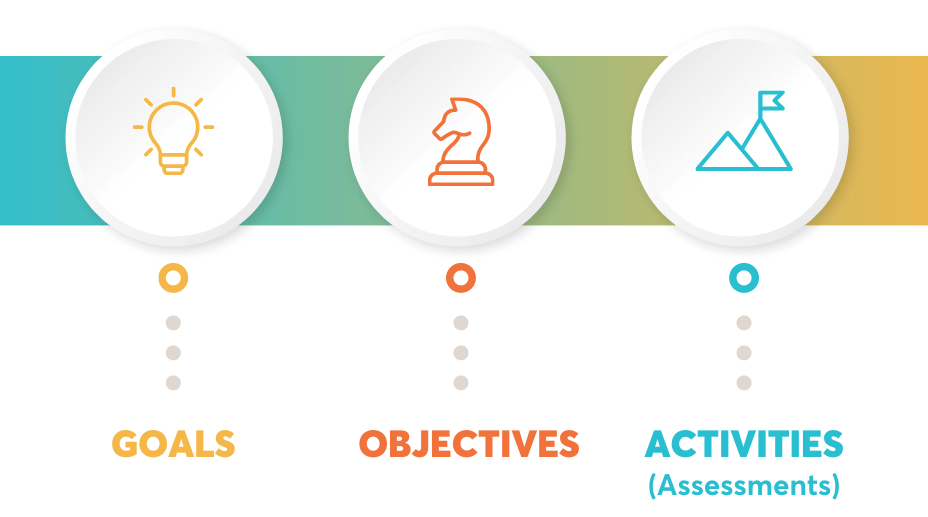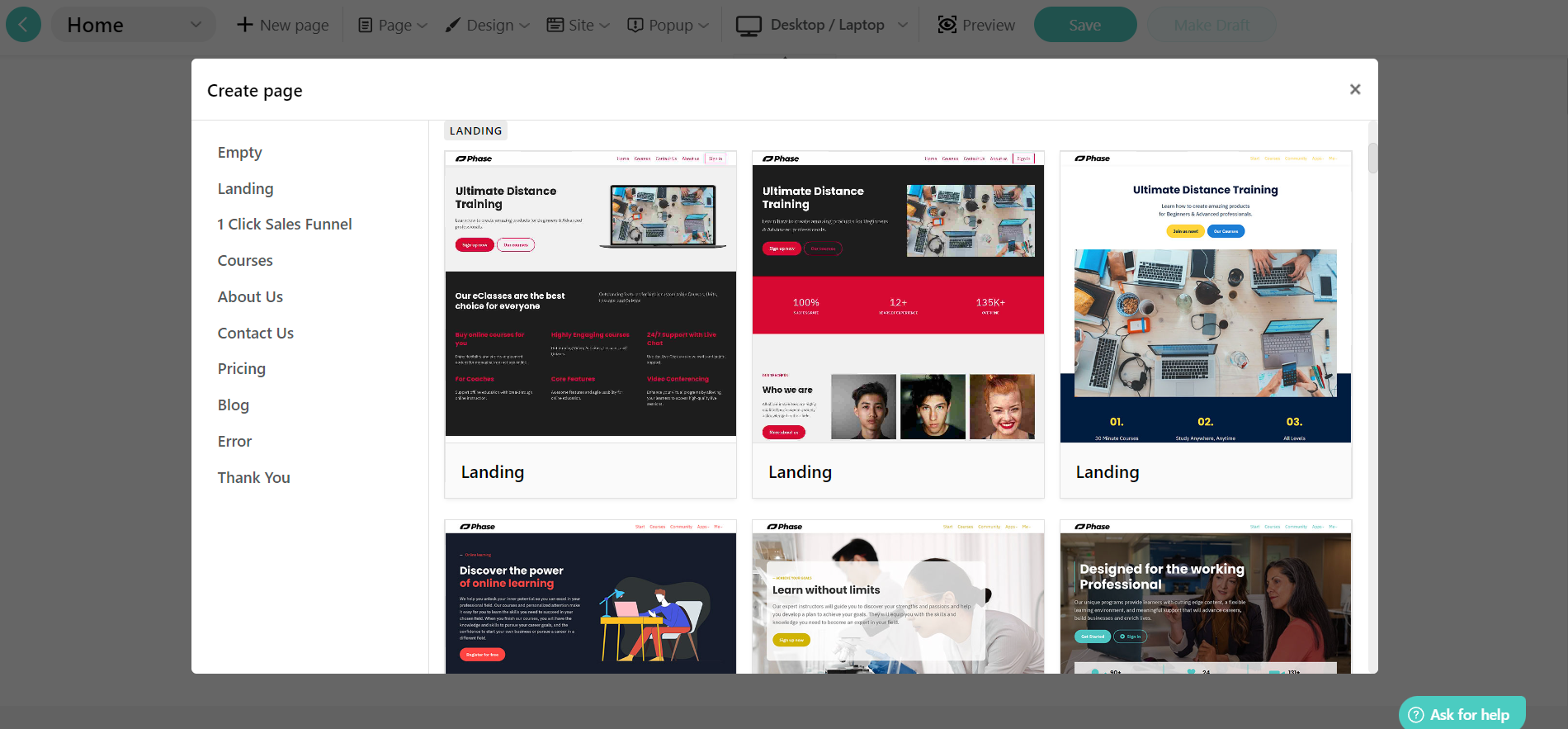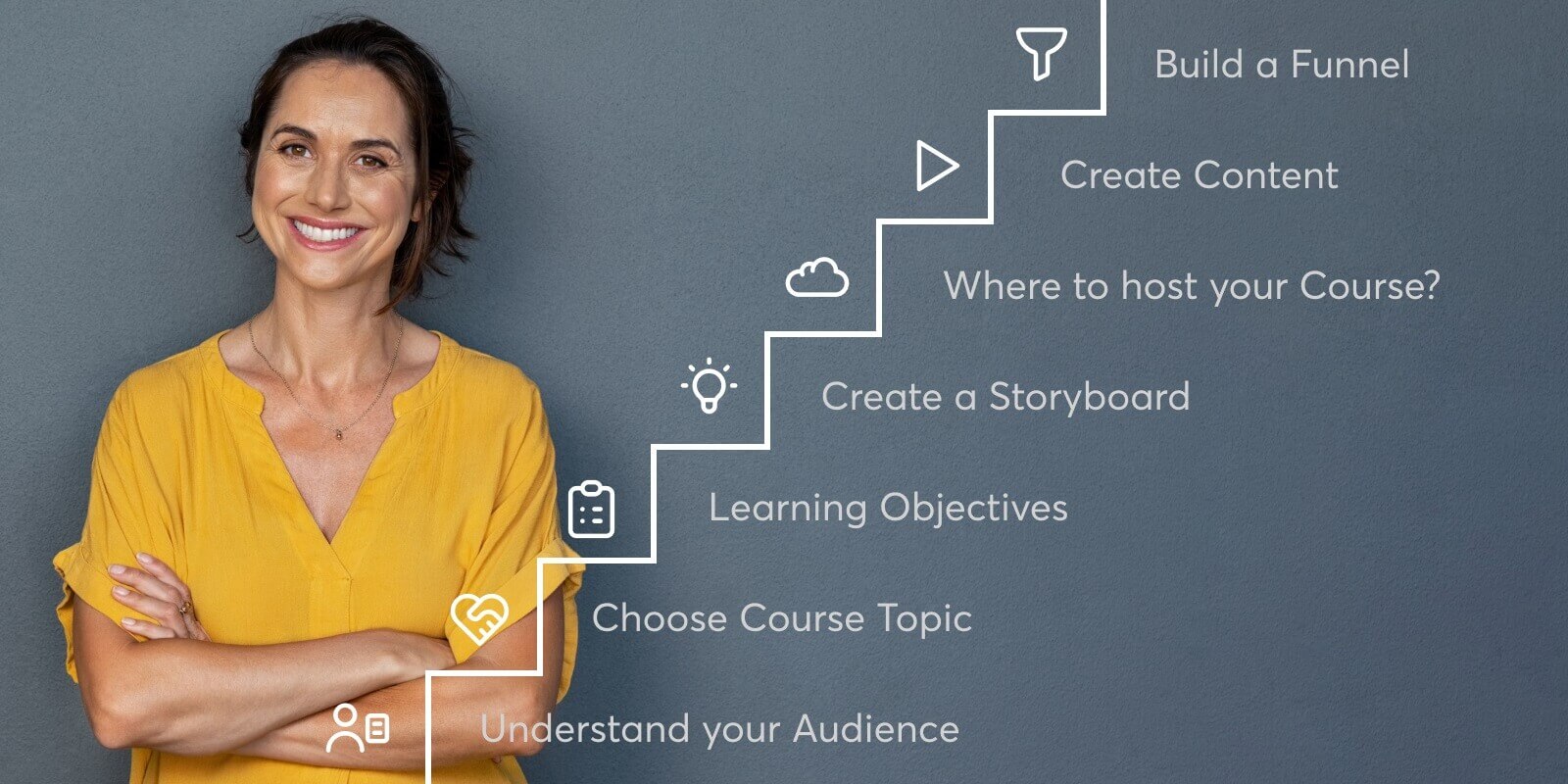Table of Contents
The creator economy is blooming. Knowledge entrepreneurs (also referred to as “edupreneurs”) are turning their expertise and passion into profitable online businesses while establishing their authority with their target audience.
If you want to join and become an edupreneur yourself, you’re in the right place.
We’ve helped hundreds of thousands of online course creators build and grow their online course businesses and create great courses. Now, we’ll teach you how to turn your knowledge into an incredible learning experience!
Through our platform, we’ve revolutionized how individuals sell courses online by building an all-in-one, powerful yet lightweight LMS designed to help course creators monetize their knowledge fast and easily.
From building flexible courses with interactive content and your own website and mobile app to promoting and selling your courses, LearnWorlds offers all the tools you need to deliver high-quality education.
This blog post is a quick course creation checklist meant to save you a significant amount of time and guide you through the fascinating journey you’re about to embark on.
We’ve documented the step-by-step process you need to follow to create and sell a successful online course enriched with interactive videos, digital downloadables, quizzes, assessments, and much more.
So let’s get started!
11 Steps to Creating and Selling Online Courses
-
-
- Step 3. Understand your Audience
- Step 4. Write Down Your Learning Objectives
- Step 5. Create a Storyboard
- Step 6. Decide Where You’ll Host Your Online Course
- Step 7. Create Your Content
- Step 8. Select a Business Model
- Step 9. Create a Course Page that Converts
- Step 10. Build a Course Sales Funnel
- Step 11. Engage in Ongoing Marketing
-
What is an Online Course?
An online course is a set of lessons or learning activities delivered through the Internet with a specific learning goal. Learning activities vary based on the modality of the course, which can be:
Most modern eLearning courses include a combination of videos, webinar recordings, PDFs and slideshows, podcasts, and quizzes. Those can be uploaded directly to a Learning Management System (LMS) or created through an authoring tool as a SCORM course.
Online courses are sold as knowledge products by course creators and elearning businesses, usually as standalone offerings or following a membership-based business model. They’re also the basis of corporate training programs delivered by organizations to employees, partners, and customers.
The 11-Step Guide to Course Creation
Below are 11 steps to success, tested & tried.
Step 1. Think Positive
Developing the right mindset is the cornerstone of success for just about anything in life. But negative thoughts tend to make their appearance and start spinning around our heads when we’re about to chase our dream or start something new.
Perhaps one or more of the following thoughts have crossed your mind:
“I don’t have the technical skills required.”
Your course, and ultimately the business that you want to create, is somewhere outside of this circle. If you’re waiting for everything to be perfect before you start building your course, you’ll never get started.
Overthinking and self-doubt create a mental block and are holding you back. Because in reality…
So, own it. You already are a knowledge entrepreneur waiting to bloom.
Step 2. Choose a Course Topic
If you’re knowledgeable about a topic that you love, be it a hobby or a job skill, then you already have a potentially profitable course idea on the table. People want to learn from someone who not only knows what they’re talking about but is also really passionate about it.
And how can you tell if the topic you have in mind is popular? Start your research from social media, especially Facebook groups and Reddit and Quora communities where people engage in discussions.
You can also search on course marketplaces for relevant topics and check the signup numbers to see which courses attract the audience the most.
For more e-course ideas, take a look at these:
Step 3. Understand your Audience
To appeal to your target audience and help your learners go from point A to point B, you need to know a few things about them. Important questions to ask:
Are they experienced with online education?
Never assume that you have all these answers. Gauge social media, send out surveys, or even ask people in your circle that match the profile of your potential customers.
Step 4. Write Down Your Learning Objectives
Learning objectives explain, with measurable verbs and with as much detail as possible, what the learner will be able to do by the end of the course.
Learning objectives are the equivalent of a value proposition, as they explain to potential customers the benefits they will gain from your course. For this reason, they should be mentioned in a prominent spot on your sales page.
Here’s an example of well-written learning objectives:
So, with learning goals, you prove that even your first course is something worth investing in. Make sure also to include them on your sales page.
Remember only to include goals that you know your audience wants to meet or fills gaps not met by your competitors.
💡 Why are learning objectives important?
Learning objectives are narrow and specific, as opposed to learning goals that are more long-term and broad. They’re directly linked to the expected results, and they can help the instructor build relevant assessments that will effectively measure whether the student has reached the desired learning outcomes of the course.

Step 5. Create a Storyboard
During the market testing and goal-setting phase, you may have put together many ideas and learning material. Now it’s time to decide what will stay and what will go.
As you’re sorting through your content, throw out anything that does not directly relate to the learning objectives you’ve set. Use a storyboard to organize your course content and visualize your course flow.
If you don’t use a storyboard, you may fall into a quagmire of structural issues. You might forget where each piece of content needs to go, what is supposed to link to where, and you will find yourself spending a lot of time trying to edit disorganized content.
💁 We have also put together another invaluable resource you can download for free, the “Definite Checklist to Design Your Course Contents.” Check it out before creating your course.
Step 6. Decide Where You’ll Host Your Online Course
Once you have your course outline ready, it’s time to think about where you’ll upload your course material and sell it as a complete course offering.
In the e-learning market, you have three options:
Option 1: Self-hosting
Many people choose to self-host their course, especially if they already have a WordPress website. In this case, you’ll have to find an LMS plugin and multiple add-ons, so that you can create a course and website with full functionality – a process that can quickly become cumbersome and confusing.
Option 2: Online course marketplaces
Course marketplaces like Udemy have a massive reach, so this option will help you get some visibility fast. Plus, you don’t need to have any technical skills to upload and start selling your course.
On the downside, selling your course via a third party means you’ll give up a big percentage of your profit as marketplaces have a high fee per sale. Another downside is that they don’t support white labeling or customization, therefore, you can’t let your personal branding stand out.
Option 3: Online course platforms
Lastly, you can use a Learning Management System or course creation platform to host your online course, with LearnWorlds, Thinkific, Podia, Teachable, and Kajabi being among the most popular choices.
This option makes online course creation a lot more simple than self-hosting or course marketplaces. Everything is one place – course creation, website building, and eCommerce with the same software.
Our platform, LearnWorlds, supports a variety of learning activities, like interactive eBooks and videos, audio files, SCORM files, self-assessments, certificates, live sessions, and many more!

We also feature a customizable website builder that requires zero technical skills and supports white labeling, plus a mobile app builder – also intuitive, customizable, white-labeled, and native!

As for marketing tools, LearnWorlds enables you to create offers & coupons, bundles, memberships & subscriptions, marketing pop-up forms, and more. We also support multiple integrations with sales and analytics tools and payment gateways, so nothing can get in the way of monetizing your knowledge.
*LearnWorlds is the best platform for creating, marketing & selling online courses. Give it a try today with a 30-day free trial!
💁 Read also:
Step 7. Create Your Content
Now it’s time to start creating your content. You need to be aware of instructional design basics for distance learning and the different ways you can deliver your course to ensure it is as engaging as possible.
For this reason, you should always have an instructional plan in mind. We have a few quick tips on that:
1. Small wins
Small wins are simple activities/challenges in your course that give your students a sense of accomplishment and confidence. They keep students excited about learning and refuel their motivation.
Include small wins throughout the course, and award your learners with badges and congratulatory pop-up messages every time they complete a challenge.
2. Scaffolding
Scaffolding is layering the learning experience, so students build on the concepts they already understand. Scaffolding requires that you gradually layer from simple concepts to more challenging ideas by telling students how this new information fits into what they already know. Keep in mind that scaffolding is an excellent way to prevent cognitive overload.
3. Active learning
It is not enough to include dozens of videos of yourself speaking into the camera or do a lot of screen recording. Learners must DO something to learn, and they must interact with each other and you whenever possible.
Use quizzes, assignments, and interactive elements to transform learners from passive to active. Social activities like course discussions and live webinars and workshops are also incredibly effective and engaging.
We have massive experience in course creation. This is why we have created 50 instructional design cards, which you can print out and use in your course creation. In this guide, you will find everything you need to know to provide appealing course content.
4. Video
Video is one of the most popular media. Learners expect some video lessons throughout the course, otherwise, your course will feel flat and impersonal. The thing is, getting started with video content can feel daunting.
And if you want a complete guide about Video-Based Learning, download our free ebook “57 Instructional Cards with Quick Tips for Amazing Videos”.
5. Build an online learning community
Although learning is somewhat of an individual activity, it is still a social process. Learners love to communicate with people on the same journey as them and share ideas.
The best value your students can ever get is from an active online learning community.
Encourage communication among the members of your community, allowing them to have a shared journey in their learning and fostering a sense of peer support.
Establishing that sense of camaraderie between fellow learners will be beneficial for everyone in the long run.
Besides, it is impossible for you, as an instructor, to have all the answers. By building a community around your online course, you’re helping your students become self-sufficient and rely on the group as well as you.
Step 8. Select a Business Model
There are many different business models to choose from when building your online academy.
Online courses
Perhaps the most common is selling courses separately or in bundles to allow for a discounted price for the learner and an easy upsell for you. The courses can be entirely self-paced or blended.
Cohort-based courses
If you’re teaching a practical subject that requires frequent communication and collaboration, you can go with a cohort-based program. This will allow learners to proceed at the same pace and support each other throughout.
Memberships
With subscriptions & membership sites, you get a monthly recurring income you can rely on. But that also means committing to adding new content at least once a month and holding some live sessions to keep the engagement.
You can even offer a mini-course or digital product (like an eBook or checklist) for free to expand your mailing list and generate leads.
💡 Pricing your course
Pricing is tricky for many new course creators. To price your course, you must find that sweet spot where your price is attractive to your learners without looking suspiciously cheap. If it does, people are less likely to trust it and will have low expectations. So, avoid being competitive in your pricing and prefer to increase the value you bring to the table.
💁 In our blog post “How to price an online course,” we go much deeper into the subject of pricing.
Step 9. Create a Course Page that Converts
Before you hit publish, create the sales page of your online course (also known as your course description, landing page, or sales letter).
The sales page is the page that describes your course. You should follow the SEO copywriting checklist to allow search engines to discover you. But, more importantly, you need to be persuasive and get people to enroll.
To create a great sales page, the first thing you have to do is answer the following three basic questions about your course:
Our powerful Site Builder with customizable templates makes it much easier for you to create a stunning website that catches the visitor’s eye and allows you to be flexible whenever you want to make changes to your sales page.

💁 Read also: How to Build an Online Course Landing Page
Step 10. Build a Course Sales Funnel
Once you have finished the course creation process, you have to win the bet of selling it successfully. This is the trickiest part.
A sales funnel is a multi-step process that turns visitors to your site into buyers. A sales funnel, in a way, describes the whole process from awareness to purchase:
Step 1 – Awareness: Potential students first become aware of your course, which offers a solution to their problem. If you’re new in the market, this is where you will need to focus – getting your course the attention it deserves!
Step 2 – Interest: You attract the interest of the potential customer. They get to know you and your products and look more into the offering.
Step 3 – Decision: Potential buyers are trying to decide whether to buy or not from you. A sales page is essential to all the previous steps, but most importantly, the decision phase helps the visitors make a decision.
Step 4 – Action/Purchase: How smooth is your sales funnel after they click on the “buy” button? How compelling are your checkout process and page? Does your site look trustworthy? These factors will help customers complete the purchase.
Understanding the structure of the sales funnel is essential because you will have to create yours, introducing marketing tactics that work for your business.
Step 11. Engage in Ongoing Marketing
There are hundreds of pieces of advice out there about digital marketing, all of which can help you with your course launch.
We have put together a very useful and handy guide that you can download, “The Ultimate Guide To Selling & Marketing Online Courses,” so you don’t get lost in selling your online course and start making money as soon as possible.
Selling online courses includes many tricks with which you can increase your conversion rates:
One thing is sure – you need an ongoing marketing strategy to promote your course and enroll students. You’ll also need to take care of other important matters that will keep your business running smoothly.
If you want to dive deeper into SEO marketing, watch this talk by Neil Patel, packed with practical advice:
As for Instagram and Facebook marketing, the “Queen of Facebook” Mari Smith shares her secrets here:
3 Common Mistakes to Avoid
That was our 11-step process for successful online course creation. If you’re building your first online course, you might be susceptible to some easily avoidable mistakes. These are the most common mistakes to watch out for:
Lengthy videos
Attention spans are getting lower, so the ideal video length is getting shorter. There are three categories of video lengths:
Worrying too much
One of the worst mistakes. Being a perfectionist is one thing, but if you are overly worried about the quality, your audience, or any other factors, your course will never go live – and this is the biggest of your problems.
Without trying, there is no chance of success. Give it a shot, test your market, make a sample course, and try to get your first paying customer. Don’t worry about all the small details and make improvements as you go. Use the lean startup method (and we also urge you to read the book, it’s an eye-opener) on building your online course or any other venture.
Forgetting to test
Like all new ventures, testing your product with real users, friends, and family is a great way to avoid silly mistakes. You might have forgotten to add a video, deleted a quiz you mention on the previous assignment, or left out the “Buy button.”
Test your course, and have someone proofread your landing pages and content for mistakes. When you work on a project, you tend to become “immune” to errors from the many times you have passed over the text.
Start Your Journey to Profitable Online Course Creation
The fact that you’re teaching the subject you love and know best opens up countless opportunities for your personal and professional development. At the same time, you get to connect with and touch the lives of people who live at the other end of the world!
Building your community through an online school or online academy is a great way to spread your knowledge while monetizing your expertise and creating a source of passive income.
So, what are you waiting for? Launch your online course today with LearnWorlds using our 30-day free trial.
Your professional looking Academy in a few clicks
Start FREE TrialFrequently Asked Questions (FAQs)
How to make an eCourse?
One way to build an e-course directly is by using a Learning Management System (LMS) or course creation platform. These tools allow you to upload your content and group it into learning modules, create additional learning activities and assessments, and manage your learners. Modern LMSs also allow you to promote and sell your courses.
Alternatively, you can use an authoring tool to create a full course before importing it to the LMS. For simpler courses, you can create videos and add them to your website, gated or ungated.
How to create a 7-day ecourse (challenge)?
A challenge course format usually requires you to release content in intervals. You can create a section with information about the challenge and a welcome video, then follow up with a daily challenge or task, where your students get access to the next activity.
Another way to do it is by sharing a checklist or a program of activities. Remember to award your learners each time they complete a challenge to keep them going strong!
In both cases, you need to include some self-reflection activities and knowledge checks, so both you and your learners can track their progress.
How to create a private ecourse?
A private course in LearnWorlds is not accessible to anyone, either for free or paid. They’re hidden courses that the admin has to give access to. You can change an ecourse to private from the settings tab of your school’s dashboard.
How to create ecourses for millennials?
Millennials have short attention spans, making it challenging for educators to maintain their attention. To make an engaging ecourse for millennials, you must prefer short, multimedia formats with highly engaging activities.
How to create video courses?
What is the best software to create ecourses?
LearnWorlds is the best modern course platform to create ecourses. It’s an all-in-one tool for elearning businesses and solo creators alike. With LearnWorlds, you can build engaging courses, host your website, sell courses, and manage users. With rich built-in functionalities and multiple integrations, you can rest assured that you’ll create a course exactly like you want it.
How to make a course to sell
A profitable online course needs research and deliberation. Make sure to first start building an audience before creating an online course. Ask your audience which topics they are more interested in, and try to pre-sell the course before you start creating the content.
How can I write a new course?
There is no one way to write a new course. All you need is patience, imagination, and a reliable eLearning platform to help you put it together. Most of all, if you love the field of your expertise, everything will come into place. In this article, you will learn everything you need to know about how to create a successful online course.
How long does it take to create an online course?
It depends on how much material you already have and how intricate you want your course to be. If you already have some PDFs and videos, then you can create some quizzes, and you’re ready to go. In this case, a week is more than enough to create an online course by working two hours a day on it.
How much does it cost to create an online course?
Again, depending on whether you have created the media you will use, the course creation may cost from zero (except for the learning platform charges) to thousands of dollars. For example, some instructors invest a lot of money in video production.
Read our guide on how much it costs to develop an online course.
How to make an online course interactive?
An interactive online course is key to better knowledge outcomes and higher engagement. To make a course more interactive, you can:
How hard is it to create an online course?
Creating a course is not as hard as it seems. You probably already have some ready-made content you can repackage and turn it into PDF infographics, eBooks, and checklists. People love video, though, so make sure to create some videos and not rely on text-based learning material only.
How to create a profitable online course?
If you want to create a profitable online course, the most important thing is to know your audience’s interests and pain points, and their preferred communication style. This way, you can create a course that brings them value and market it effectively by speaking their language.
A profitable course always:
Your professional looking Academy in a few clicks
Start FREE TrialNick Malekos is a Senior Digital Marketer in LearnWorlds. He is a results based and well-rounded Digital Marketer with years of experience in the education industry, writer and digital literacy trainer.

Androniki Koumadoraki
Androniki is a Content Writer at LearnWorlds sharing Instructional Design and marketing tips. With solid experience in B2B writing and technical translation, she is passionate about learning and spreading knowledge. She is also an aspiring yogi, a book nerd, and a talented transponster.




